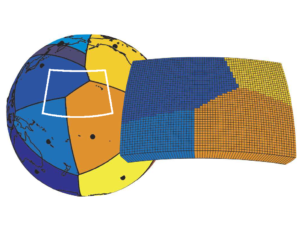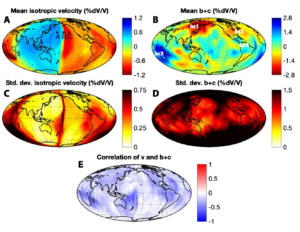
With collaborators Scott Burdick at Wayne State University and Lauren Waszek at New Mexico State University — both former Maryland postdocs — we just published the first tomographic model of Earth’s inner core in Earth and Planetary Science Letters.
Seismic body wave and normal mode analyses have revealed that the inner core is solid, strongly anisotropic, and characterized by dramatic quasi-hemispherical differences in elastic structure and attenuation. Yet, despite these discoveries, the highly heterogeneous and incomplete data coverage of the inner core has impeded the development of tomographic models even at the longest wavelengths. Here, we use a probabilistic and transdimensional tomographic approach (TBI) on a newly expanded dataset of P-wave travel-times sensitive to the upper 120 km of the inner core. The TBI approach yields a ensemble of parsimonious models that simultaneously capture both the dominant hemispheric dichotomy and laterally abrupt velocity variations. Figure 1 shows the Voronoi cell parameterization and the underlying grid used to speed up computations. Analysis of the model ensemble allows us to determine the locations of the hemisphere boundaries and rule out the presence of hemispheric dichotomy in anisotropy (Figure 2). Instead, we robustly map regional variations in anisotropy beneath Africa and the eastern Pacific, and detect variations at high latitudes suggesting that cylindrical anisotropy may not be adequate for describing the uppermost inner core.

